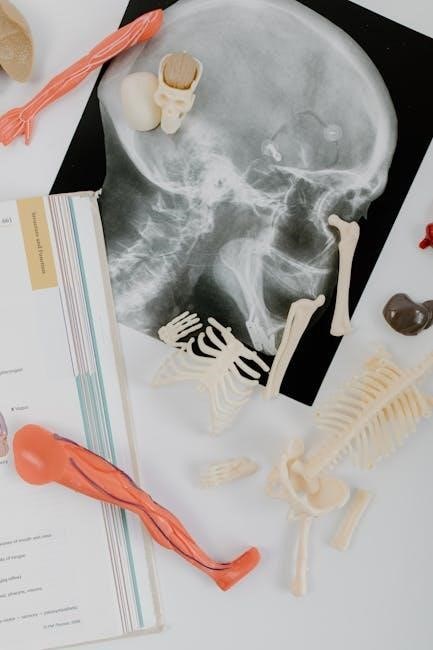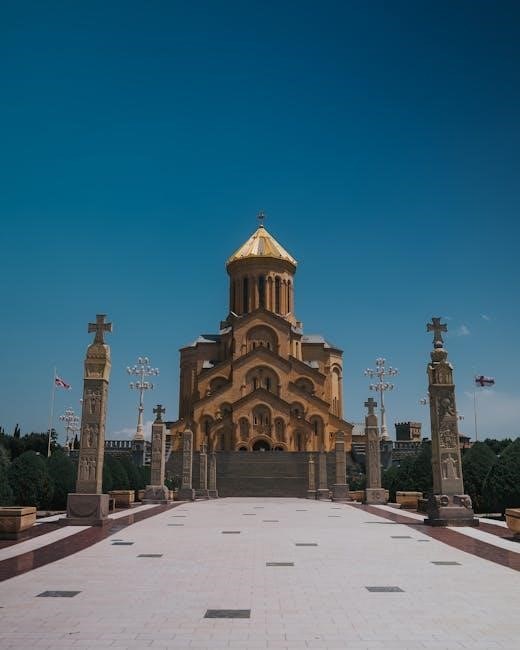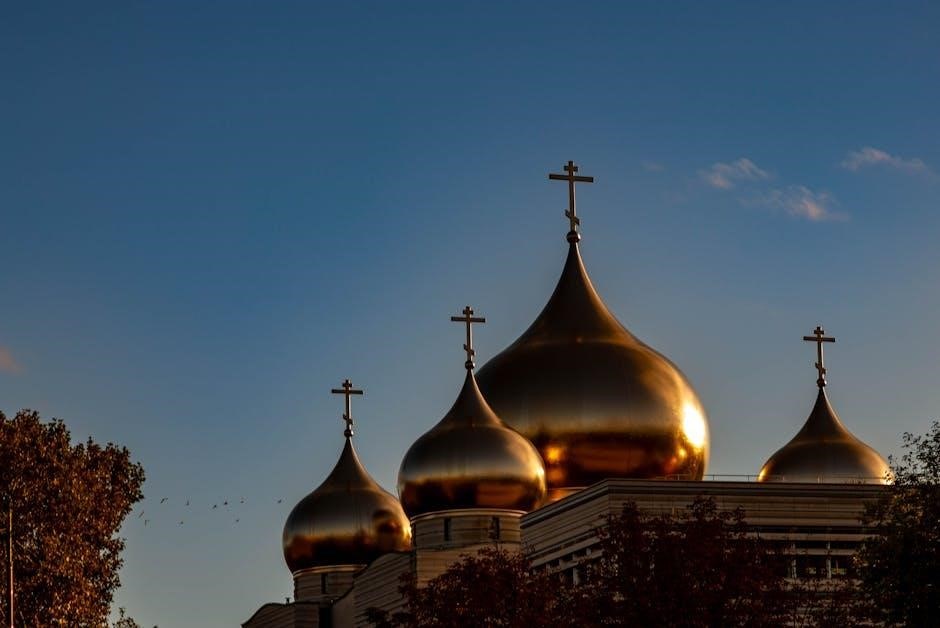Effective Modern C++ by Scott Meyers is a comprehensive guide to mastering C++11 and C++14. It provides practical guidelines for writing efficient, modern C++ code, focusing on key features like braced initialization, nullptr, and move semantics. The book is essential for developers seeking to leverage modern C++ standards effectively, ensuring their code is both robust and future-proof.
Overview of Modern C++ and Its Importance
Modern C++ represents a significant evolution in the language, emphasizing efficiency, safety, and expressiveness. Introduced with C++11 and refined in C++14, it addresses historical pitfalls while adding powerful features. Modern C++ prioritizes zero-cost abstractions, enabling high-performance code without sacrificing readability. Its importance lies in its ability to tackle complex systems programming while maintaining backward compatibility. Key advancements include move semantics, smart pointers, and concurrency support, which simplify resource management and parallelism. As a result, Modern C++ is indispensable for building robust, scalable, and maintainable applications across domains, from embedded systems to high-performance computing. Resources like Scott Meyers’ Effective Modern C++ provide essential guidance for mastering these advancements.
The Evolution of C++: From C++11 to C++14
C++11 marked a revolutionary step in the language’s history, introducing features like auto type deduction, lambdas, and move semantics. These innovations aimed to improve efficiency and readability. Building on this foundation, C++14 refined and expanded these capabilities, enhancing constexpr functions, extending lambda expressions, and simplifying variable templates. Together, these standards modernized C++, enabling developers to write cleaner, more expressive code while maintaining performance. Resources such as Scott Meyers’ Effective Modern C++ provide insights into leveraging these features effectively, ensuring developers can harness the full potential of modern C++ in their projects. This evolution has solidified C++’s role in contemporary software development.
Scott Meyers’ Contribution to Modern C++

Scott Meyers has significantly influenced modern C++ programming through his book Effective Modern C++, which provides 42 specific ways to improve the use of C++11 and C++14. His work is renowned for its clear, example-driven approach, making complex concepts accessible. Meyers’ contributions include emphasizing move semantics, smart pointers, and constexpr functions, which are crucial for efficient and modern C++ code. His guidance has helped developers transition to newer standards seamlessly. As a respected authority, Meyers’ insights have shaped how programmers leverage modern C++ features, ensuring their code is both efficient and maintainable. His impact continues to inspire the C++ community worldwide.

Core C++11 and C++14 Features
C++11 and C++14 introduced groundbreaking features like braced initialization, nullptr, and decltype, enhancing code clarity and safety. These updates simplified resource management and improved performance, shaping modern C++ practices.
Braced Initialization and Its Benefits
Braced initialization, introduced in C++11, provides a uniform way to initialize objects. It simplifies syntax, reduces ambiguity, and prevents narrowing conversions. This feature is especially useful for const and reference types, ensuring safer and more predictable code. By using braces, developers can consistently initialize variables, arrays, and even aggregates, making code more readable and maintainable. Scott Meyers highlights its importance in Effective Modern C++, emphasizing how it aligns with modern C++ idioms and best practices, leading to cleaner and more robust codebases.
Understanding nullptr and Its Usage
nullptr is a C++11 keyword that represents a null pointer type. It was introduced to resolve ambiguities caused by using 0 or NULL, which can be interpreted as integers. Unlike its predecessors, nullptr is type-safe and explicitly indicates a null pointer, enhancing code clarity and preventing potential bugs. Its usage is recommended for initializing pointers, comparing against null, and passing null arguments to functions. Scott Meyers emphasizes nullptr in Effective Modern C++ as a modern alternative that aligns with best practices, ensuring safer and more maintainable code. By adopting nullptr, developers can write more robust and readable code, adhering to contemporary C++ standards.
decltype and Its Role in Modern C++
decltype is a powerful C++11 feature that automatically deduces the type of an expression, enhancing type safety and expressiveness. It is particularly useful for declaring variables, return types, and template parameters. Unlike typeof, decltype preserves the constness and referenceness of expressions, making it ideal for scenarios where precise type information is crucial. Scott Meyers highlights its importance in Effective Modern C++, showcasing how it simplifies code and reduces redundancy. By leveraging decltype, developers can write more concise and maintainable code, ensuring better type correctness and adherence to modern C++ practices. Its adoption is a key step in mastering the language’s evolving capabilities.

Effective Modern C++: The Book by Scott Meyers
Effective Modern C++ by Scott Meyers is a definitive guide to C++11 and C++14. It offers 42 specific ways to improve modern C++ programming, ensuring efficiency and clarity.
Structure and Content of the Book
Effective Modern C++ is structured to guide developers through C++11 and C++14 features with clarity. The book is divided into chapters, each focusing on specific modern C++ techniques such as move semantics, smart pointers, and concurrency. With 42 concise items, Meyers provides actionable guidelines and examples to enhance programming practices. The content emphasizes avoiding common pitfalls and leveraging new language features effectively. Written in an accessible style, the book is ideal for experienced developers seeking to modernize their skills. Available in PDF, it remains a valuable resource for mastering contemporary C++ programming.
Target Audience and Prerequisites
Effective Modern C++ is tailored for experienced C++ developers familiar with earlier standards. The book assumes a solid understanding of C++ fundamentals, such as classes, templates, and pointers. It is particularly beneficial for programmers transitioning to C++11 and C++14, offering practical insights to enhance their coding proficiency. The content is designed to help developers avoid common pitfalls and adopt modern practices seamlessly. Whether working on systems programming, embedded systems, or high-performance applications, this guide empowers professionals to write efficient, readable, and maintainable code. The PDF version is widely accessible, making it a convenient resource for continuous learning and reference.
Reception and Reviews of the Book
Effective Modern C++ has received widespread acclaim for its clear, example-driven approach. Reviewers praise Scott Meyers’ ability to simplify complex topics like move semantics and concurrency. Many consider it a must-read for modern C++ development, with professionals highlighting its practical advice for improving code quality. The book is often described as essential for developers transitioning to C++11 and C++14. Its structured format and real-world examples make it accessible while maintaining depth. The PDF version is particularly popular for its convenience and readability. Overall, the book is celebrated as a definitive guide, earning high praise from both experienced programmers and those seeking to enhance their skills in modern C++ programming.

Writing Effective Modern C++ Code
Effective Modern C++ emphasizes mastering C++11 and C++14 features. It provides guidelines for writing clean, efficient code, focusing on move semantics, smart pointers, and avoiding common pitfalls to ensure robust and modern C++ programming practices.
Avoiding Common Pitfalls in C++11/C++14
Avoiding common pitfalls in C++11 and C++14 is crucial for effective modern C++ programming. Scott Meyers highlights potential issues such as incorrect use of decltype, misuse of noexcept, and overlooking move semantics. He emphasizes understanding the nuances of braced initialization to prevent unintended behavior. Meyer’s guidelines help developers steer clear of subtle bugs and performance bottlenecks, ensuring their code is both correct and efficient. By following these best practices, programmers can harness the power of modern C++ while avoiding its most common traps, leading to cleaner, more maintainable codebases.
Mastering Move Semantics
Mastering move semantics is a cornerstone of effective modern C++ programming. Scott Meyers explains how move semantics optimize resource management by transferring ownership instead of copying, reducing unnecessary overhead. He provides clear guidelines on implementing move constructors and move assignment operators, while emphasizing the role of rvalue references. Meyers also discusses the interaction of move semantics with smart pointers and containers, ensuring efficient memory usage. By understanding these concepts, developers can write more performant and resource-efficient code, leveraging C++11 and C++14 features effectively. This approach is vital for modern C++ development, enabling better control over object lifetimes and resource allocation.
Effective Use of Smart Pointers
Effective use of smart pointers is a key aspect of modern C++ programming. Scott Meyers emphasizes the importance of replacing raw pointers with unique_ptr and shared_ptr to manage memory safely and efficiently. He explains how unique_ptr enforces exclusive ownership, while shared_ptr allows shared ownership with automatic reference counting. Meyers also covers weak_ptr for observing shared objects without extending their lifetime. Proper use of these smart pointers helps prevent memory leaks, dangling pointers, and undefined behavior. By following Meyers’ guidelines, developers can write more robust and exception-safe code, aligning with modern C++ best practices and ensuring reliable resource management.

Modern C++ Memory Management
Modern C++ emphasizes efficient memory management through RAII and smart pointers, eliminating leaks and dangling pointers. It advocates for unique_ptr and shared_ptr over raw pointers, ensuring safer, more efficient code.
RAII (Resource Acquisition Is Initialization) Idiom
RAII is a fundamental concept in Modern C++ that binds resource acquisition to object construction and release to destruction. This idiom ensures resources like memory or file handles are automatically managed, preventing leaks and dangling pointers. By tying resource lifetime to object lifetime, RAII eliminates manual memory management and reduces the risk of exceptions causing resource leaks.
RAII is implemented through constructors and destructors, making resource management intuitive and less error-prone. It aligns with Modern C++’s focus on safety and efficiency, enabling developers to write robust, exception-safe code without compromising performance. This approach is widely adopted in C++11 and C++14, as discussed in Effective Modern C++.
Smart Pointers: unique_ptr, shared_ptr, and weak_ptr

Smart Pointers: unique_ptr, shared_ptr, and weak_ptr
Smart pointers in Modern C++ revolutionize memory management, offering safer alternatives to raw pointers. unique_ptr ensures exclusive ownership, automatically releasing resources when out of scope. shared_ptr allows shared ownership, with reference counting to manage resource lifetime. weak_ptr provides non-owning references, preventing circular dependencies without causing leaks.
These pointers simplify resource management, reduce manual operations, and align with RAII principles. They are essential tools for writing efficient, modern C++ code, as emphasized in Effective Modern C++ by Scott Meyers. Their use is highly recommended for maintaining code safety and performance in C++11 and C++14 applications.
Modern Alternatives to new and delete
Modern Alternatives to new and delete
In Modern C++, manual memory management using new and delete is discouraged due to potential memory leaks and dangling pointers. Instead, smart pointers like unique_ptr and shared_ptr provide automatic memory management. These alternatives ensure resources are properly released when no longer needed. Additionally, containers and algorithms from the Standard Template Library (STL) often eliminate the need for manual memory allocation. The make_unique and make_shared helper functions further simplify the creation of smart pointers. By adopting these modern practices, developers reduce the risk of memory-related bugs and align with the RAII (Resource Acquisition Is Initialization) idiom, as recommended in Effective Modern C++ by Scott Meyers.

Concurrency in Modern C++
Concurrency is crucial for efficient programming in Modern C++. Scott Meyers’ book provides insights into leveraging these features effectively for better performance and responsiveness in applications.
Lambda expressions, introduced in C++11, enable concise, inline definitions of anonymous functions. They consist of a parameter list, an optional mutable keyword, an exception specification, a body, and a return type. These expressions are particularly useful for event handlers, standard algorithm callbacks, and closures. They can capture variables from the surrounding context, allowing for flexible and expressive code. Scott Meyers’ Effective Modern C++ provides detailed guidance on using lambdas effectively, emphasizing best practices to avoid common pitfalls, such as excessive capturing or unintended side effects; Properly used, lambdas enhance code readability and maintainability, making them a cornerstone of modern C++ programming.
Asynchronous Programming with async and await
C++11 introduced async and await to simplify concurrent programming, enabling developers to write asynchronous code that is more readable and maintainable. These features allow functions to suspend and resume execution, making asynchronous operations feel like synchronous ones. Scott Meyers highlights how to use these effectively in Effective Modern C++, emphasizing their integration with futures and promises for seamless concurrency. He provides guidelines to avoid common pitfalls, such as unhandled exceptions or unnecessary blocking, and recommends using async/await with coroutines for more complex asynchronous tasks. Proper use of these features ensures efficient and scalable concurrent code, aligning with modern C++ best practices for performance and readability.
Avoiding Concurrency Pitfalls
Concurrency in modern C++ can be error-prone if not handled correctly. Common pitfalls include race conditions, deadlocks, and data corruption due to improper synchronization. Scott Meyers in Effective Modern C++ emphasizes the importance of understanding memory models and avoiding low-level constructs like raw pointers. He advocates for using high-level concurrency tools such as std::async, std::future, and mutexes to prevent issues. Meyers also warns against over-synchronization, which can degrade performance, and suggests leveraging lock-free data structures where possible. By adhering to best practices and using standard library utilities, developers can write efficient, thread-safe code that avoids the complexities and risks associated with manual concurrency management.

Best Practices for Modern C++ Development
Effective Modern C++ emphasizes const correctness, exception handling, and adhering to modern coding standards. These practices ensure code reliability, readability, and optimal performance in C++11 and C++14.
Const Correctness and Its Importance
Const correctness is a fundamental principle in modern C++ that enhances code reliability and maintainability. By declaring variables or parameters as const when they shouldn’t be modified, developers ensure data integrity and prevent unintended side effects. This practice is particularly crucial in multi-threaded environments and when working with large codebases. Tools like const_ptr and constexpr further support this paradigm, allowing for compile-time evaluation of expressions. Scott Meyers emphasizes the importance of const correctness in Effective Modern C++, highlighting its role in making code more predictable and easier to reason about. Adopting this practice is essential for writing robust and modern C++ code.
Exception Handling and Resource Management
Effective exception handling and resource management are critical in modern C++ to ensure robust and reliable code. The RAII (Resource Acquisition Is Initialization) idiom is a cornerstone of C++ programming, tying resource ownership to object lifetimes. This prevents resource leaks and ensures proper cleanup, even in the face of exceptions. Scott Meyers emphasizes the use of smart pointers like unique_ptr and shared_ptr to automate memory management. By combining these tools with exception-safe practices, developers can write code that is both exception-neutral and resource-leak-free. Proper exception handling and resource management are essential for maintaining code integrity and preventing runtime errors in modern C++ applications.
Coding Standards for Modern C++
Coding standards in modern C++ are essential for maintaining clarity, consistency, and efficiency. Scott Meyers’ Effective Modern C++ emphasizes adhering to best practices, such as using auto for type deduction and avoiding outdated constructs. The book highlights the importance of const correctness, which ensures data integrity and reduces side effects. Additionally, it advocates for the use of modern features like structured bindings and class template argument deduction. By following these standards, developers can write cleaner, more efficient, and maintainable code. Tools like static analysis and modern compilers further support these practices, helping developers align with the evolving C++ ecosystem and avoid common pitfalls. These standards are vital for writing robust, modern C++ code.

The Impact of Effective Modern C++
Effective Modern C++ has profoundly shaped C++ programming by providing clear, practical advice for adopting modern standards. Its influence is evident in widespread industry adoption and community acclaim.
How the Book Influenced C++ Programming
Effective Modern C++ revolutionized C++ programming by clarifying and promoting modern C++11 and C++14 features. Scott Meyers’ clear, example-driven approach made complex concepts accessible, influencing both individual developers and industry practices. The book’s focus on move semantics, smart pointers, and best practices helped standardize modern C++ usage. Its impact is evident in updated coding standards, improved library implementations, and widespread adoption of modern C++ idioms across the software industry, ensuring the language remains efficient, expressive, and adaptable to contemporary challenges;
Community Feedback and Adoption
The C++ community has widely embraced Effective Modern C++, praising its clarity and practical insights. Developers and organizations have adopted its guidelines, leading to improved coding standards and practices; The book’s focus on modern features has accelerated the transition to C++11 and C++14, making it a cornerstone of professional development. Positive reviews highlight its accessibility and depth, benefiting both experienced programmers and those new to modern C++. Its influence is evident in industry-wide adoption, with many considering it a must-read for staying current with C++ evolution.
Additional Resources for Further Learning
Beyond Effective Modern C++, learners can explore online resources like cppreference.com for detailed documentation. Platforms such as Pluralsight and Coursera offer courses on modern C++. The C++ Subreddit and Stack Overflow provide community support for specific questions. For deeper insights, CppCon talks and ISO C++ Committee materials are invaluable. Books like “More Effective C++” by Scott Meyers and “The C++ Programming Language” by Bjarne Stroustrup complement the learning journey. These resources ensure a well-rounded understanding of modern C++ practices and standards.
Effective Modern C++ by Scott Meyers is a cornerstone for mastering C++11 and C++14. It bridges the gap between older standards and modern practices, making C++ more accessible and efficient for developers. The book’s practical advice and clear examples have revolutionized how programmers approach the language, ensuring their code is both maintainable and high-performance. As a result, it remains an indispensable resource for anyone aiming to excel in modern C++ development.
Effective Modern C++ by Scott Meyers provides essential insights into leveraging C++11 and C++14 features. Key takeaways include mastering move semantics, understanding braced initialization, and effectively using nullptr and decltype. The book emphasizes smart pointers like unique_ptr and shared_ptr for modern memory management. It also covers lambda expressions and asynchronous programming with async and await. Meyers highlights the importance of RAII and avoiding common pitfalls in modern C++. The book serves as a practical guide for developers to transition from older standards to modern C++, ensuring efficient, readable, and maintainable code. Its clear examples and guidelines make it indispensable for anyone aiming to excel in modern C++ development.
Final Thoughts on Modern C++ Development
Modern C++ development, as highlighted in Effective Modern C++, emphasizes efficiency, clarity, and safety. By embracing features like move semantics, smart pointers, and concurrency, developers can write robust, maintainable code. Scott Meyers’ guidance underscores the importance of avoiding pitfalls and leveraging modern tools. The shift from raw pointers to unique_ptr and shared_ptr exemplifies this evolution. As C++ continues to evolve, staying updated with standards and best practices is crucial. Meyers’ work serves as a cornerstone for developers aiming to master modern C++, ensuring their code remains efficient, readable, and aligned with contemporary standards. The book’s insights are invaluable for fostering a deeper understanding of C++’s capabilities and potential.


















































